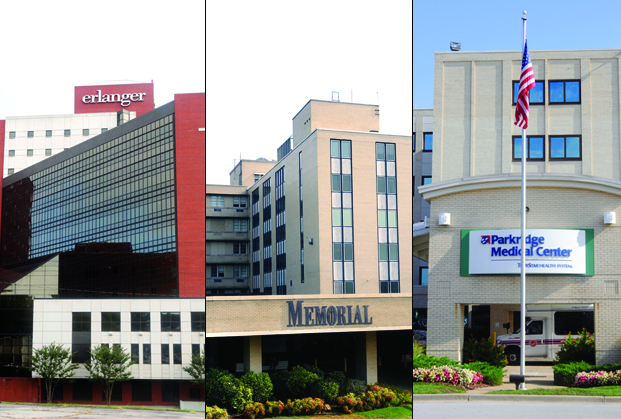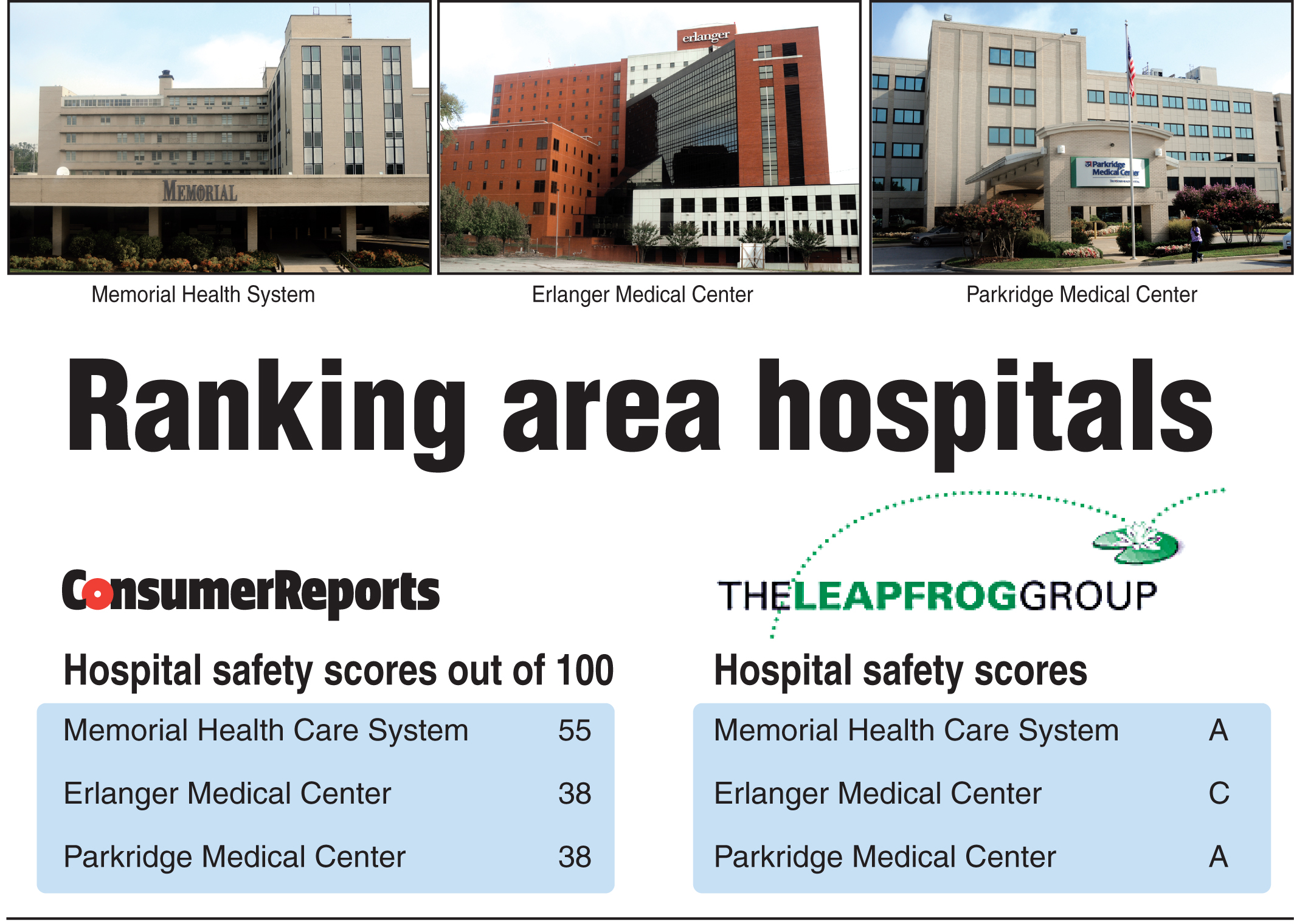Scores can provide valuable consumer information about Chattanooga hospitals
Friday, January 1, 1904
Consumer Reports Hospital Safety ScoresChance heart attack patients will be readmitted to hospital within 30 daysErlanger: 21 percentMemorial: 18 percentParkridge: 21 percentPercentage of scanned patients who received double abdominal scansErlanger: 26 percentMemorial: 38 percentParkridge: 23 percentPercentage of patients who said staff always or usually explained about new medicationsErlanger: 79 percentMemorial: 83 percentParkridge: 78 percentHow hospitals compare to the national average in avoiding serious complicationsErlanger: Worse than averageMemorial: Better than averageParkridge: Similar to averageSource: Consumer Reports
One local hospital gets an A for patient safety, another scores 55 out of 100 on overall safety, while a third is rated worse than the national average for serious complications.
In the last few months, several national groups have released hospital safety scores, ranking individual hospitals on their patient care, infection rates and patient satisfaction. The sudden increase of information comes as federal and state requirements now have hospitals publicly reporting on more and more safety measures, said Dr. Daniel Pollock, a medical epidemiologist at the Centers for Disease Control and Prevention.
"This information used to be kept within the four walls of hospitals, but the time is long past when that is acceptable," Pollock said. "It is the responsibility of the health care system to be transparent and responsible for the outcomes that occur."
Last week, well-known product reviewer Consumer Reports released its first-ever hospital safety score. Across the country, hospitals were given a number grade from 1 to 100 based on six measures -- infections, readmissions, overuse of scanning, communication about new medications and discharge, complications and mortality.
Locally, Memorial Health Care System received 55 out of 100, while Erlanger Medical Center and Parkridge Medical Center each got 38 out of 100.
Nationally, Billings Clinic, in Billings, Mont., got the highest score -- 72 -- out of the 1,159 hospitals rated, while Sacred Heart Hospital in Chicago received only 16 out of 100. Just over half the hospitals received scores of less than 50 out of 100, according to a news release from Consumer Reports.
The magazine reported that infections, surgical mistakes and other medical harm contribute to the deaths of 180,000 hospital patients a year.
Hospital-associated infections are in the top 10 causes of death, according to the CDC.
"Clearly, this is an ongoing problem and we have to do a better job," Pollock said.
FLOOD OF DATA
Earlier this year The Leapfrog Group, an independent national nonprofit run by employers and other large purchasers of health benefits, gave hospitals letter grades based on a hospital safety score. Hospital Compare, a website created by the federal Centers for Medicare and Medicaid Services, offers safety and patient outcome information on individual hospitals.
But each of the rankings uses different evaluation methods and provides different scores, making it difficult for patients to assess just how safe their local hospitals are. In addition, a hospital may do well on avoiding infections but get bad scores for readmission rates.
Patients should use the information to evaluate their hospitals, but should look at all the information and understand what is being measured, Pollock said.
"Quality of care is a complex phenomenon, and each piece of information has to be put into perspective," he said.
In addition to looking at the reports and data, Pollock said patients should talk to their health care practitioners before choosing a hospital.
Both Consumer Reports and The Leapfrog Group used state and federal data collected by the CDC's National Healthcare Surveillance Network and reported by the Centers for Medicare and Medicaid. But each also collected its own data through surveys.
Pollock said he has not studied either report closely enough to evaluate their reliability.
Consumer Reports said its ratings include only 18 percent of hospitals because data on patient safety isn't reported consistently nationwide.
"Hospitals that volunteer safety information, regardless of their score, deserve credit, since the first step in safety is accountability," says Dr. John Santa, director of the Consumer Reports Health Ratings Center, in a news release. "But the fact that consumers can't get a full picture of most hospitals in the U.S. underscores the need for more public reporting."
Patients can expect to see even more information soon, Pollock said. For example, under requirements beginning next year, hospitals must report instances of clostridium difficile, an inflammation of the colon that typically occurs after using antibiotics and kills about 14,000 people a year, Pollock said.
HOSPITAL RESPONSE
Some hospitals have contested the rankings and new information, saying they do not adequately evaluate the hospitals or reflect the complexity of safety measures. In addition, a hospital's size or the type of patients its serves can adversely affect outcomes, they say.
The reports also lag several years, meaning they may not reflect recent improvements.
The data used by Consumer Reports is two to four years old, Pat Charles, spokeswoman for Erlanger, wrote in an email. The Centers for Medicare and Medicaid provide the most accurate and up-to-date information, Charles wrote.
The Tennessee Department of Health released more recent information in June, showing that Tennessee hospitals now have surgical site and bloodstream infection rates below the national baseline. That study included information through June 2011.
Pollock acknowledged the reporting process lags behind real-time data. As hospitals switch to electronic data, the information will be available much more quickly, he said.
Parkridge and Memorial officials said they support the increased public awareness and information available to patients.
"We want patients to understand how we are working to keep them safe while they are in our facilities," Parkridge spokeswoman Alison Counts wrote in an email. "Rankings provide part of the story, but patients and families can learn a lot about the care they are receiving in the hospital by asking questions and communicating with hospital staff and their physicians."
The Consumer Reports score used the same publicly available data sources as other groups that have reported information, noted Memorial spokeswoman Lisa McCluskey.
"It engages the consumer to be accountable care partners and teaches them how to be aware and part of their care plan," McCluskey wrote in an email.


